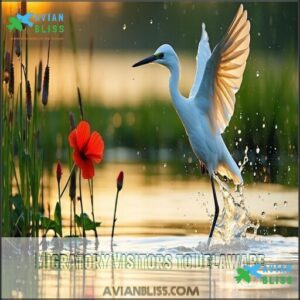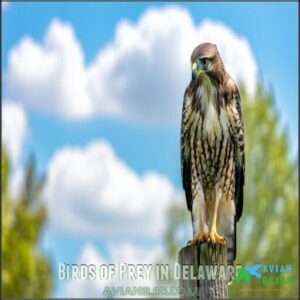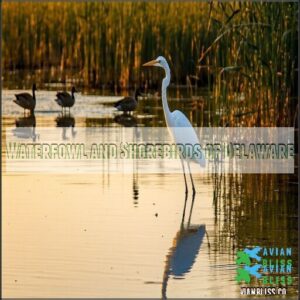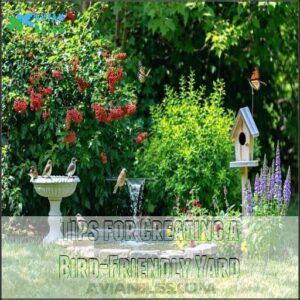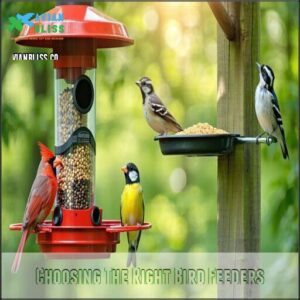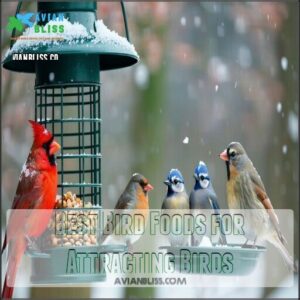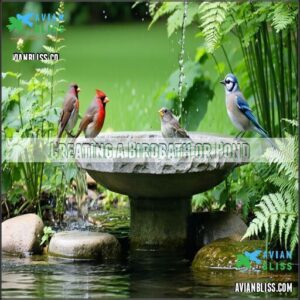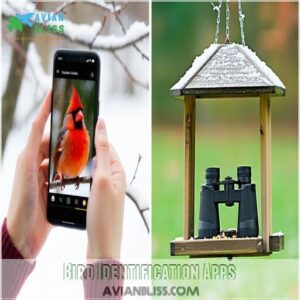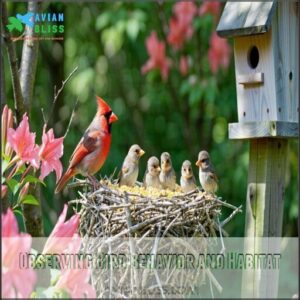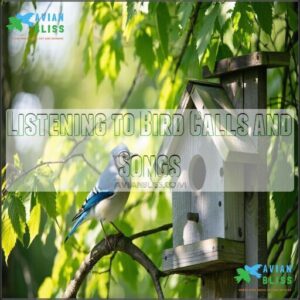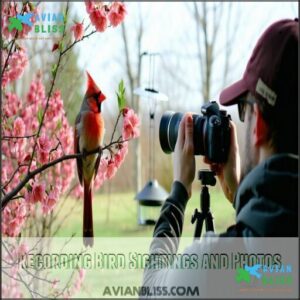This site is supported by our readers. We may earn a commission, at no cost to you, if you purchase through links.
 Delaware’s backyards are bustling with feathered friends all year.
Delaware’s backyards are bustling with feathered friends all year.
You’ll spot vibrant Northern Cardinals, cheerful Carolina Wrens, and curious Blue Jays flitting about.
In winter, look for Dark-eyed Juncos hopping near feeders or snow-dusted White-throated Sparrows.
Summer brings Ruby-throated Hummingbirds zipping between flowers like tiny jewels.
Keep an eye open for Downy Woodpeckers drilling into tree trunks or the sharp dive of a Cooper’s Hawk.
Don’t forget water features—Mourning Doves and American Robins love splashing in birdbaths.
Whether you’re a beginner or a seasoned birder, Delaware offers incredible diversity.
Stay tuned for tips on attracting these beauties to your yard!
Table Of Contents
- Key Takeaways
- Year-Round Residents of Delaware
- Migratory Visitors to Delaware
- Birds of Prey in Delaware
- Waterfowl and Shorebirds of Delaware
- Delaware’s Unique Bird Species
- Attracting Birds to Your Backyard
- Identifying Birds in Delaware
- Frequently Asked Questions (FAQs)
- What birds live in Delaware?
- Is there birding in Delaware?
- Are there bluebirds in Delaware?
- Which bird feeder attracts the most birds in Delaware?
- Do you see birds at feeders or backyards in Delaware?
- What is the state bird of Delaware?
- How do I identify a bird in my backyard?
- What is the most common bird in Delaware?
- What is the Delaware state bird?
- How do I find out what birds are in my area?
- Conclusion
Key Takeaways
- Create a bird-friendly yard by providing native plants, clean water features, and feeders stocked with seeds like sunflower and suet to attract Delaware’s diverse bird species.
- Pay attention to bird behavior, colors, and songs to identify species like Northern Cardinals, Ruby-throated Hummingbirds, and Downy Woodpeckers in your backyard.
- Delaware hosts migratory visitors like Ruby-throated Hummingbirds and Snowy Egrets, so update feeders and habitats seasonally to welcome them.
- Avoid pesticides and offer nesting spots like birdhouses or shrubs to support birds and create a safe, thriving ecosystem.
Year-Round Residents of Delaware
You’ll find that many birds in Delaware stick around all year, offering consistent beauty and activity to your backyard.
From the vibrant Northern Cardinal to the busy Tufted Titmouse, these species are well-adapted to the state’s changing seasons.
Blue Jay
Blue Jays are some of the smartest Delaware backyard birds you’ll find, known for their lively personalities and striking blue feathers.
Blue Jays bring charm and intelligence to your yard with their vibrant feathers and playful antics.
Their intelligence shows through behaviors like mimicking other birds and stashing acorns for future feasts.
These birds enjoy peanuts, sunflower seeds, and suet, so setting up a backyard buffet can quickly attract them.
With their crests resembling crowns, they bring a regal flair to your yard, while their social antics keep things entertaining.
- Blue Jay Diet: Peanuts, suet, sunflower seeds.
- Jay Mimicry: Mimics hawks and other birds.
- Jay Socialization: Highly interactive flock behavior.
American Robin
The American Robin is a busybody among Delaware birds.
Whether you’re watching it hunt worms or peck at berries, its orange-red belly and chirpy Robin Song will catch your eye.
A common sight in Delaware backyard birds, they’re loved for their energetic behaviors year-round.
Here’s a quick guide to help you learn more:
| Feature | Detail | Fun Fact |
|---|---|---|
| Diet | Worms, berries | Can eat up to 14 feet of worms daily! |
| Habitat | Lawns, gardens, forests | Prefers open spaces with trees |
| Nesting | Trees, shrubs, ledges | Builds nests using mud and grass |
| Migration | Short-distance migrant | Stays year-round in warmer areas |
Northern Cardinal
The Northern Cardinal is a favorite among Delaware birds, brightening backyards all year with its fiery plumage and sweet, melodic songs.
Males flash vibrant red, while females display elegant tawny hues.
Known for shared parenting and adaptability, these backyard birds thrive on a diet of seeds, fruits, and insects.
Spotting one perched near feeders is a treat for bird watching enthusiasts and beginners alike!
Carolina Wren
If you’ve heard bubbly, cheerful tunes in your Delaware backyard, you’ve likely spotted a Carolina Wren. These curious singers thrive year-round.
Carolina Wrens fill backyards with cheerful songs, bringing bright energy and charm to your garden all year long.
To attract them, focus on:
- Wren Behavior: Provide brush piles or shrubs for their nesting needs.
- Feeding Habits: Offer suet, mealworms, or peanut butter.
- Habitat Preference: Plant native shrubs for cover.
- Nesting Details: Maintain clean birdbaths—they adore fresh water.
Happy bird watching!
House Sparrow
The House Sparrow is one of Delaware’s most common backyard birds, thriving in urban spots and suburban yards alike.
Known for their scavenging knack and noisy personality, they gobble seeds, crumbs, and just about anything.
Thanks to their amazing Sparrow Adaptability and curious Sparrow Behavior, they’re easy to spot for bird identification enthusiasts.
Love them or not, these bold neighbors are here to stay!
Mourning Dove
Mourning Doves are peaceful backyard birds that grace Delaware wildlife with their soft cooing.
These year-round residents symbolize tranquility and are easy to spot if you know where to look:
- Dove Habitats: They perch in trees or shrubs, often near open spaces.
- Dove Nesting: Look for flimsy nests tucked into branches.
- Dove Diet: They flock to feeders filled with seeds and grains.
- Dove Sounds: Their gentle calls add calm to any yard.
Downy Woodpecker
The Downy Woodpecker is a delightful addition to Delaware’s backyard birds.
Its bold black-and-white plumage and rhythmic drumming make it stand out.
With a diet of insects and seeds, it thrives in tree cavities—its go-to habitat for nesting and winter survival.
Often mistaken for similar species, this small woodpecker offers a great bird identification challenge.
Spotting one adds charm to any backyard.
White-throated Sparrow
The White-throated Sparrow is a charming winter guest in Delaware. Its bold black-and-white stripes and sweet “Oh-sweet-Canada” song make it hard to miss.
These backyard birds flock to feeders for seeds and berries, adding life to chilly days. Look for them hopping under shrubs or nearby bushes.
- Striking black-and-white stripes
- Prefers shrubs for cover
- Enjoys seeds and berries
- Social winter flocks
- Sweet, melodic song
Tufted Titmouse
The Tufted Titmouse is a lively backyard bird you’ll love spotting in Delaware.
This gray-blue feathered species thrives in wooded areas and cozy yards. Their playful antics include stash-and-save behaviors, hiding food like sunflower seeds for later.
- Titmouse Habitat: Prefers trees and shrubs.
- Titmouse Diet: Enjoys sunflower seeds, suet, peanuts.
- Titmouse Nesting: Builds with bark, moss, and fur.
- Titmouse Behavior: Bold, curious, seed hoarders.
- Titmouse Vocalizations: Cheerful “peter-peter-peter” calls brighten mornings.
A delightful sight for birdwatching enthusiasts!
Dark-eyed Junco
The Dark-eyed Junco, fondly called a “snowbird,” is easy to identify with its gray feathers, crisp white belly, and pinkish beak.
You’ll find these backyard birds in Delaware during winter, foraging for seeds under feeders or fluttering through bushes.
Their precise migration habits and lively tail flicks make them a treat for bird identification and bird watching enthusiasts seeking winter beauty.
House Finch
The House Finch is a backyard favorite in Delaware with males flashing red and females donning soft browns.
Their lively songs brighten any space, making them irresistible.
Want to attract these beauties?
- Finch Diet: Stock up on sunflower seeds and berries.
- Finch Habitat: Use tube feeders with perches.
- Finch Behavior: Plant shrubs or trees nearby for nesting.
Enjoy birdwatching!
Migratory Visitors to Delaware
Each year, migratory birds pass through Delaware, bringing bursts of color and sound to backyards and wetlands.
You’ll spot species like the Ruby-throated Hummingbird and Snowy Egret as they stop to rest and refuel during their long journeys.
Ruby-throated Hummingbird
The Ruby-throated Hummingbird is a backyard gem, like a tiny green firecracker zipping through the sky.
These energetic birds, common in Delaware, rely on rich nectar sources to fuel their long Hummingbird Migration journey. Add native plants like trumpet vine or bee balm to attract these feathered acrobats. Keep your Hummingbird Feeders filled with a simple sugar-water mix—no red dyes needed!
They’ll appreciate a shady spot to beat the heat and frequent cleaning to keep their food safe. Their flight capabilities allow them to be expert, agile fliers.
Here’s how to protect them:
| Challenge | Solution | Fun Tip |
|---|---|---|
| Window strikes | Add decals or screens | Fun bird-shaped stickers |
| Cats nearby | Keep cats indoors | Try cat-safe fencing |
| Bees invading | Use bee guards | Pick ant-friendly spots |
Expect these shimmering visitors every summer!
Little Blue Heron
The Little Blue Heron, a true wetland gem, sports dark blue adult feathers yet starts with white juvenile plumage, often confusing birdwatchers.
Preferring marshes and swamps, this graceful hunter wades through shallow waters, using its sharp bill to snatch fish and frogs.
While its conservation status remains stable, preserving these bird habitats guarantees they keep enriching Delaware’s backyard birdwatching and showcasing stunning bird species diversity.
Greater Yellowlegs
The Greater Yellowlegs is a must-see among migratory birds in Delaware. With long, elegant legs and slightly upturned bills, they wade gracefully through wetlands.
Understanding their migration patterns can boost your birdwatching success. Their leg length aids wading in mudflats.
To spot them, follow these steps:
- Look near wetland birdwatching locations during their migration.
- Listen for sharp, high-pitched calls to spot them.
- Watch for their distinct feeding habits and leg-stretching strides.
- Bring binoculars—small details reveal this bird species’ beauty.
Lesser Yellowlegs
The Lesser Yellowlegs is a graceful migratory bird you’ll often find in Delaware’s wetlands during its seasonal journeys.
With long, slender, bright yellow legs, it wades confidently through muddy waters, searching for insects, tiny fish, and other aquatic prey—key aspects of its diet.
This medium-sized species, smaller than its Greater Yellowlegs relative, is well-suited to marshes and mudflats.
To identify them, look for their sleek, needle-like bill and their high-stepping gait.
Despite being fascinating to watch, their conservation status highlights the importance of protecting wetland habitats for this and other migratory bird species in Delaware.
Snowy Egret
The Snowy Egret, often called nature’s ballerina, dazzles Delaware’s wetlands with its delicate white plumage and striking black legs.
These graceful migratory birds thrive in wetlands, a key Snowy Egret Habitat.
Here’s why they’re fascinating:
- Egret Plumage Details: Elegant snowy feathers and flowing plumes.
- Egret Feeding Habits: Dive for fish and insects expertly.
- Birding Locations: Wetland birdwatching hotspots across Delaware.
- Egret Conservation Status: Their survival underscores protecting wetlands.
Green Heron
The Green Heron is a clever wetlands resident you’ll love spotting during birdwatching in Delaware.
Compact and colorful, these backyard birds are pros at sneaky fishing tricks, even using tools like bait to catch prey! Look for them near marshes or shallow water.
- Green Heron ID: Greenish-black feathers, chestnut chest, yellow legs.
- Heron Habitat: Wetlands, marshes, and edges of streams.
- Heron Diet: Fish, insects, and frogs.
- Heron Behavior: Creative strategies for hunting.
Glossy Ibis
Spotting a Glossy Ibis in Delaware’s wetlands feels like encountering a living gemstone.
These sleek, social birds shimmer in sunlight, displaying iridescent greens and purples.
Keep an eye on marshes during spring and summer—that’s their favorite habitat.
Known for their unique feeding habits, they probe mud for insects and fish.
Protecting wetlands is key since habitat loss threatens them.
Bring your binoculars; Ibis identification is fun and rewarding for birdwatching enthusiasts exploring Delaware’s rich bird species diversity.
Osprey
Ospreys, often called “fish hawks,” are a star of Delaware’s bird species diversity.
With sharp vision and amazing fishing skills, these raptors patrol Delaware’s waterways in summer. Their diet is almost entirely fish, making them fascinating to watch while hunting.
Delaware Osprey nests, built from sticks, are often perched high on platforms or tall trees—perfect birdwatching locations.
Once endangered, their conservation status has greatly improved, thanks to pesticide bans and dedicated efforts. For birdwatching in Delaware, spotting an Osprey in flight or near its nest is always an unforgettable experience.
Their resilience truly inspires bird enthusiasts everywhere, and observing them is a highlight of Delaware’s bird species diversity, making the state a great location for birdwatching.
Birds of Prey in Delaware
You’ll find some of Delaware’s most awe-inspiring birds right in your backyard, circling high or perched silently.
From sharp-eyed hawks to stealthy owls, these predators play a pivotal role in keeping ecosystems balanced.
Northern Harrier
The Northern Harrier, also called the Marsh Hawk, is a fascinating bird of prey often seen gliding low over fields and marshes in Delaware. With V-shaped wings, a white rump patch, and an owl-like facial disk enhancing its hunting behavior, it’s truly distinctive.
These raptors thrive in wetlands, so a conservation mindset helps.
- Recognizable field marks include its long tail and yellow legs.
- Hunts rodents by sound, gliding stealthily.
- Avoids snowy areas during migration seasons.
Eastern Screech Owl
The Eastern Screech Owl is a tiny predator with big charm, often camouflaging expertly in tree bark.
These nocturnal hunters thrive in varied owl habitats, feasting on a versatile Screech diet of insects, mice, and small birds. Their haunting owl sounds, like trills and whinnies, add mystery to Delaware nights.
Boost your chances of spotting one:
- Install bird boxes or leave natural tree cavities.
- Avoid pesticides to create a safe bird habitat.
- Visit birdwatching locations in Delaware and listen for calls at dusk.
Bald Eagle
The Bald Eagle, America’s symbol of strength, thrives in Delaware with over 100 nests.
Spot them near water, soaring with incredible wingspans or perched, scanning prey. Their nesting habits favor secluded areas, reflecting successful eagle conservation efforts.
Here’s more:
| Feature | Description |
|---|---|
| Wingspan | Up to 7 feet |
| Diet | Fish, small mammals |
| Status | Protected species |
Patience is key to spotting these regal backyard birds!
Turkey Vulture
You’ve likely seen Turkey Vultures, nature’s cleanup crew, soaring effortlessly over Delaware. With their bald, red heads and dark feathers framed by silver-tipped underwings, they’re built for handling carcasses.
These scavengers use their sharp sense of smell to sniff out carrion, keeping ecosystems clean.
- Vulture Identification: Large wingspan with a slight V-shape in flight.
- Feeding Habits: Prefers decaying animal matter.
- Ecological Role: Nature’s cleanup team, preventing disease spread.
- Conservation Status: Stable, often seen near roadsides.
Red-tailed Hawk
Red-tailed Hawks are the acrobats of Delaware’s skies, gliding effortlessly over fields and roadsides. They’re easy to spot, thanks to their broad wings, brown bodies, and that iconic red tail—an identifying marking unique to adults.
You might hear their loud, raspy scream, famously used in Hollywood for dramatic effect.
These backyard birds are skilled hunters, with a diet focused on rodents and rabbits, helping keep pests in check. Their nests, perched high in tall trees, are impressive sights for birdwatchers.
Enjoy this quick guide:
| Trait | Detail | Fun Fact |
|---|---|---|
| Wingspan | 4-5 feet | Perfect for long, soaring flights |
| Diet | Rodents, rabbits | Essential for balance in ecosystems |
| Habitat | Fields, trees | Ideal hunting grounds |
American Kestrel
The American Kestrel is Delaware’s smallest falcon, easily recognized by its striking plumage and agile hunting style.
These backyard birds thrive in open spaces, snacking on insects and small rodents.
Unfortunately, habitat loss threatens their numbers.
By supporting kestrel conservation, offering man-made nesting boxes, and visiting birdwatching locations, you can help preserve these vibrant raptors while enjoying their fascinating behavior up close with a bird identification guide.
Cooper’s Hawk
The Cooper’s Hawk is a stealthy predator often gliding through Delaware’s backyards and woodlands.
Their long tails and broad wings make them stand out. These backyard birds use speed and agility to hunt small birds and rodents.
- Cooper’s Hawk ID: Rounded tail with dark bands, piercing red eyes.
- Hunting Behavior: Surprise attacks from perches.
- Habitat Preference: Forests, suburban areas.
- Nesting Habits: Stick nests in tall trees.
- Conservation Status: Stable, adapting well to urban habitats.
Sharp-shinned Hawk
The Sharp-shinned Hawk is like the stealthy ninja of backyard birds in Delaware.
These agile raptors are built for speed and precision, perfect for their hunting behavior near feeders.
- Hawk Identification: Short, rounded wings and long tails make sharp turns effortless.
- Habitat Preferences: Found in forests and suburban areas.
- Backyard Interactions: They often surprise bird watchers with their swift, calculated dives.
Perfect for bird watching and bird identification enthusiasts!
Waterfowl and Shorebirds of Delaware
You’ll spot some of Delaware’s most fascinating waterfowl and shorebirds near wetlands, ponds, and coasts.
From the elegant Great Egret to the quirky American Coot, these species are perfectly adapted to life near the water.
Wood Duck
The Wood Duck is a showstopper among Delaware’s native birds.
Found in wooded wetlands and ponds, their iridescent feathers and bold patterns make them stand out.
These local birds prefer habitats with calm water and nearby trees, ideal for nesting habits.
Add a nesting box, and you might see adorable ducklings paddling through your yard!
Their diet includes acorns, seeds, and insects, making Woodies a joy to spot.
Mallard
Mallards are among the most familiar native birds in Delaware.
Recognized by their glossy green heads and distinct white neck rings, these common birds thrive in urban ponds and wetlands.
A key part of their Mallard behavior is “dabbling,” where they tip forward to feed on plants and small creatures underwater—an amusing sight.
Mallard habitat often overlaps with backyard feeders near water sources, so you might spot them waddling through.
They’re essential to the ecosystem, with efforts in Mallard conservation supporting wetland health, which is a result of their unique behavior, such as “dabbling”.
Northern Shoveler
The Northern Shoveler, with its spoon-shaped bill, stands out among Delaware’s waterfowl.
It’s like the vacuum cleaner of wetlands, using its specialized beak to filter insects, seeds, and plankton while dabbling. Often spotted in shallow marshes and ponds, these ducks are popular with birdwatchers.
Come fall, their migratory journeys bring them to Delaware, where protected areas provide a safe haven. Their sleek, waterproof plumage isn’t just for show—it’s key to efficient feeding.
- Shoveler Identification: Spoon-like beak, striking plumage.
- Shoveler Habitat: Wetlands, marshes, shallow ponds.
- Shoveler Diet: Small prey, seeds, insects, plankton.
- Shoveler Migration: Long-distance travelers.
- Shoveler Conservation: Thrive in wetlands protection areas.
Willet
Imagine strolling Delaware’s coastal habitats and spotting a Willet, a sleek shorebird easily recognized by its long legs and striking black-and-white wings during flight.
Thriving in mudflats and sandy beaches, Willet habitat supports their diet of crustaceans and small fish.
Known for their dramatic "broken wing" act to distract predators, these birds charm and amaze.
Willet migration takes them across the Atlantic coast, showcasing their adaptability and resilience. Adding Willet identification to your birdwatching checklist is a rewarding nod to Delaware’s rich bird diversity.
Great Blue Heron
The Great Blue Heron is one of Delaware’s common birds and a highlight in any bird guide.
With long legs and sleek blue-gray feathers, it’s built for hunting fish and frogs in wetland shallows.
Keep an eye out for its slow, deliberate movements and sharp beak.
Protecting heron habitats supports heron conservation while ensuring you’ll spot these graceful creatures frequently at top Delaware birding locations. It’s a must on your bird identification charts!
Great Egret
The Great Egret is a breathtaking sight in Delaware’s wetlands, with snowy white feathers, a sharp yellow bill, and sleek black legs.
Known for their elegance and hunting precision, they target fish and crustaceans with impressive patience. In spring, their breeding plumage truly shines.
Once endangered, these remarkable birds are now thriving thanks to conservation efforts.
- Egret Habitat: Wetlands, marshes, and ponds.
- Egret Behavior: Silent and stealthy hunters.
- Egret Identification: Striking white plumage and long neck.
Canada Goose
The Canada Goose is a familiar sight in Delaware, often spotted grazing or flying in iconic V formations.
Known for their resilience and loud honks, they’re a hallmark of migratory birds.
Their nesting is thorough, ensuring offspring thrive.
| Feature | Canada Goose Facts |
|---|---|
| Size | Large (up to 14 lbs) |
| Diet | Grasses, grains |
| Behavior | Social, migratory |
| Habitat | Wetlands, parks, fields |
They’re a essential part of Delaware’s bird species and ecosystems.
American Coot
Ever spot an American Coot in Delaware? These quirky birds blend into ponds but are fun to recognize.
- Coot Identification: Duck-like body, white bill, and dark feathers.
- Coot Habitat: They thrive in marshes and dense vegetation.
- Coot Diet: Loves snacking on aquatic plants and insects.
- Coot Behavior: Expert nest-builders, creating floating homes in reed-filled waters.
Delaware’s Unique Bird Species
In Delaware, you’ll find some truly unique birds that stand out for their striking colors and fascinating behaviors.
From the loud call of the Pileated Woodpecker to the cheerful charm of the Eastern Bluebird, these species highlight the state’s rich avian diversity.
Pileated Woodpecker
The Pileated Woodpecker is a standout with its bold black-and-white plumage and striking red crest.
Its hammering creates rectangular cavities, a signature of woodpecker habitat preferences.
You’ll often spot these giants near dead trees, where they forage for ants—a key diet detail.
Known for loud “kuk-kuk-kuk” calls and undulating flight, they assist ecology by recycling forests.
For bird identification, compare similarities with the Red-bellied, Hairy, or Downy Woodpecker in Delaware woodlands.
Belted Kingfisher
You’ll often spot a Belted Kingfisher perched near waterways in Delaware, scanning for prey before its famous sharp plunge into the water.
Fascinating to watch, their Kingfisher Habitat includes riverbanks with sandy shores for burrowing nests.
This species sticks to a fish-heavy Kingfisher Diet year-round.
Birders can improve their skills with bird identification basics.
For birdwatchers, their rattling Kingfisher Sounds and unique behaviors make them unforgettable!
Red-winged Blackbird
The Red-winged Blackbird is a bold presence in Delaware’s marshes. Males flaunt red and yellow wing patches, while females blend into their wetland habitat with streaked brown feathers.
Here’s what makes them fascinating:
- Territorial Behavior: Males fiercely defend nests.
- Red-wing Diet: They love insects and grains.
- Flock Dynamics: Winter brings large migratory flocks, offering stunning sights.
Brown-headed Nuthatch
The Brown-headed Nuthatch is a small Delaware wonder, zipping through pine forests and chirping like a rubber ducky.
These clever climbers use their chisel-like bills to extract seeds from bark.
Boost your birdwatching experience by setting up nest boxes—a fundamental conservation step.
| Feature | Details | Observation Tip |
|---|---|---|
| Habitat Preference | Open pine forests | Look near mature trees |
| Nesting Habits | Cavities in dead trees | Install a birdhouse nearby |
| Feeding Behavior | Seeds, insects | Watch them up-close near feeders |
| Identifying Features | Brown cap, rubbery call | Listen for squeaky vocalizations |
| Conservation Status | Declining locally | Support with habitat-friendly yards |
American Goldfinch
The American Goldfinch, famous for its seasonal plumage changes, brightens Delaware backyards.
In summer, males flaunt vivid yellow feathers, but winter fades them to olive-gray.
Their diet preferences include nyjer seed, thistle, and sunflower, making them regular visitors to feeders. Their undulating flight adds grace to bird watching.
These social birds are drawn to native plants for nesting habits while delighting bird lovers with cheerful song variations.
Attracting Goldfinches with proper feeders and seeds offers opportunities for playful bird identification adventures right in your own backyard! Brightens Delaware backyards. Seasonal plumage changes.
Eastern Bluebird
With their brilliant blue wings and warm orange chests, Eastern Bluebirds are true backyard showstoppers.
In Delaware, they thrive in open fields, meadows, and woodlands, but they’re also big fans of bird houses.
Feed them mealworms, and they’ll reward you with cheerful songs. Plant native berry shrubs to keep their bellies full and their spirits high.
To encourage nesting, place a well-designed box in a quiet spot.
- Quick Tip: Bluebird Behavior shines during early mornings—watch for their swooping flights as they hunt insects or gather nesting materials.
Attracting Birds to Your Backyard
You can attract more birds to your backyard by providing food, water, and shelter adapted to their needs.
Simple changes like adding native plants and keeping feeders stocked with seeds can make a big difference.
Tips for Creating a Bird-Friendly Yard
Create a bird-friendly yard by combining native plants, water sources, and shelter options into a safe haven for your feathered visitors.
Sprinkle native plants like holly or elderberry to serve as both food and nesting spots.
Add a birdbath or small pond—birds love splashes!
Keep feeders tidy, stocked with bird seeds adapted to local species.
Dense shrubs double as ideal shelters while enhancing your bird-friendly garden.
Bird houses placed thoughtfully inspire observation fun.
A little effort creates a thriving, happy backyard ecosystem!
To further enhance your yard, consider providing essential water for hydration.
Choosing The Right Bird Feeders
Choosing the right bird feeders can turn your backyard into a bird paradise.
With so many options, it’s smart to match feeders with your feathered visitors. Here’s a quick guide:
- Tube Feeders: Excellent for seeds like sunflower or Nyjer. Goldfinches and chickadees will quickly gather to enjoy.
- Hopper Feeders: These hold mixed seeds and attract cardinals and sparrows alike. Their sturdy design handles busy bird traffic.
- Platform Feeders: Open and versatile, perfect for doves and juncos.
- Suet Feeders: Great for attracting woodpeckers with high-energy treats.
- Sturdy Build: Weatherproof and squirrel-resistant designs save frustration and money.
Consider exploring different tube feeder options for smaller birds.
For effortless bird feeding, remember placement matters and clean feeders regularly! You’ll love the birds that come flocking.
Best Bird Foods for Attracting Birds
Bird feeding in Delaware is all about matching Seed Preferences to seasonal needs.
Black oil sunflower seeds are popular across Feeder Types, while suet excels in winter. Add peanuts for high-fat snacks and millet for small birds like juncos. For hummingbirds, try nectar.
Here’s a quick guide:
| Food Type | Attracts | Best Season | Presentation |
|---|---|---|---|
| Black Oil Sunflower | Cardinals, Jays | Year-Round | Tube or platform |
| Suet | Woodpeckers, Wrens | Winter | Suet cages |
| Millet | Sparrows, Doves | Year-Round | Scattered or feeders |
| Peanuts | Blue Jays, Woodpeckers | Year-Round | Platform feeders |
Many prefer this type of seed for bird feeding.
Experiment with these bird attraction strategies to keep your native backyard vibrant!
Creating a Birdbath or Pond
Looking to create a bird-friendly backyard? A birdbath or small pond promises happy, chirping visitors.
Aim for shallow ponds or baths for safe access. Add a mister or dripper—birds adore fresh, moving water!
Keep cleaning frequency high to prevent algae buildup.
Use native plants for birds to create a lush, inviting space. Consider browsing a shallow birdbath selection for suitable options.
Guarantee proper winter care by replacing frozen water.
- Pick shallow designs for safety.
- Include moving water sources for excitement.
- Maintain cleanliness regularly.
- **Add native pond plants.
- **Avoid deep water features.
Planting Native Vegetation
Adding native vegetation to your bird-friendly garden supports Delaware’s ecosystem while attracting specific birds.
Start with these:
- Black-eyed Susans: Their seed-filled cones are irresistible to Goldfinches.
- Serviceberry Trees: Birds flock for their berries, especially in spring.
- Purple Coneflowers: Add vibrant charm and invite butterflies too.
By choosing local plants, you’ll create a sustainable bird habitat.
Combine this with bird feeders for a yard brimming with life year-round.
Avoiding Pesticides and Herbicides
Skip pesticides—birds will thank you! Natural alternatives like hand-picking pests or blending bug-repelling plants protect feeders and native plants while supporting bird conservation.
Organic pest control keeps bird-friendly yards healthier and safer for habitats year-round.
| Natural Method | Benefit |
|---|---|
| Hand-picking pests | No chemicals, safe gardening |
| Bug-repelling plants | Supports habitat preservation |
| Compost for healthy soil | Encourages thriving gardens |
| Mulching garden beds | Reduces invasive weeds |
| Installing birdhouses | Observes bird behavior closely |
Identifying Birds in Delaware
You can identify Delaware’s birds by noticing their colors, behaviors, and habitats. Pay attention to their songs and calls too, as these can be as unique as their feathers.
Bird Identification Apps
Bring your birding game to life with bird identification apps! These handy tools make identifying bird species in Delaware a breeze. Snap a picture, record a chirp, or track sightings—perfect for hobbyists and seasoned birders.
Here’s what to look for in an app:
- Sound Identification to recognize calls instantly.
- App Accuracy offering precise bird species identification in Delaware.
- Feature Comparison for easy photo or feather ID.
- Recording Sightings to track your backyard visitors.
- Community Sharing to connect with local birders.
Upgrade your bird-watching with these digital sidekicks!
Observing Bird Behavior and Habitat
Spotting birds isn’t just about looks—it’s about understanding their world.
Observe nesting habits, like where a robin builds or how wrens tuck into shrubs.
Watch for feeding patterns—some birds nibble at feeders, while others forage on the ground.
Notice social interactions during flocks or bird communication through varied calls.
Delaware’s habitats, from wetlands to forests, shape these behaviors.
Recognizing habitat preferences sharpens both your bird watching skills and conservation awareness.
Noting Plumage Patterns and Colors
To master Plumage Identification, study bird coloration closely.
Bright hues like a Northern Cardinal’s red or the American Robin’s orange breast stand out.
Notice Color Variations tied to Seasonal Plumage—summer’s vibrant shades may dull in winter.
Watch for unique tail or wing patterns and Juvenile Plumage differences.
Aberrant Coloration, though rare, adds intrigue.
Bird identification charts simplify recognizing Delaware’s feathered friends! Bright hues like a Northern Cardinal’s red or the American Robin’s orange breast stand out.
Listening to Bird Calls and Songs
Birdsong identification adds a magical layer to bird watching.
Pay attention to a Blue Jay’s sharp “jeer” or the Carolina Wren’s bubbly tune—nature’s acoustic ecology at its finest.
Early mornings are best, as the dawn chorus showcases impressive song complexity.
Record bird sounds to untangle their unique calls.
Apps or bird identification charts can help decode vocal mimicry or intricate bird communication.
Listening closely sharpens skills but makes spotting feathered singers even more rewarding.
Recording Bird Sightings and Photos
Recording bird sightings is easy and fun with a bit of planning! Use these quick tips:
- Log species on eBird checklists and try bird watching apps.
- Snap bird pictures with steady long lenses for clear photo identification.
To improve your viewing experience, remember binocular weight and comfort.
- Record sound for citizen science and detailed data analysis.
- Organize bird photography in folders or Delaware bird guides.
Capture moments to cherish!
Frequently Asked Questions (FAQs)
What birds live in Delaware?
Delaware hosts over 427 bird species, from year-round residents like Northern Cardinals and Blue Jays to seasonal visitors like White-throated Sparrows and Ruby-throated Hummingbirds.
Whether urban or rural, you’ll find diverse feathered friends.
Is there birding in Delaware?
You bet there’s birding in Delaware!
With hundreds of species to spot, from colorful warblers to majestic eagles, it’s a birder’s paradise.
Pack your binoculars and explore wetlands, forests, and beaches for spectacular sightings!
Are there bluebirds in Delaware?
Bluebirds in Delaware are like jewels in the garden—vivid and eye-catching.
Eastern Bluebirds, with their vibrant blue feathers and rusty chests, thrive here.
They love fields, meadows, and berry bushes, often nesting in birdhouses.
Which bird feeder attracts the most birds in Delaware?
A tube feeder with multiple perches, filled with black oil sunflower seeds, attracts the most birds.
It’s like hosting a buffet—they’re irresistible to finches, cardinals, chickadees, and more.
Add a water source for bonus guests!
Do you see birds at feeders or backyards in Delaware?
It’s like hosting nature’s biggest dinner party—birds flock to Delaware feeders and backyards year-round!
Plentiful sparrows, radiant cardinals, and curious chickadees join the feast, especially with seeds, suet, and fresh water on the menu.
What is the state bird of Delaware?
Delaware’s state bird is the Blue Hen Chicken.
Designated in 1939, it’s not an official breed but is famous for its striking steel-blue feathers, symbolizing the state’s heritage and resilience with a unique flair.
How do I identify a bird in my backyard?
Start with the basics: check its size, colors, and patterns.
Notice the beak shape—it hints at its diet.
Watch behaviors like hopping or flying.
Use apps or guides for quick ID.
What is the most common bird in Delaware?
You’ll often spot the Northern Cardinal as Delaware’s most common bird.
Its bright red feathers and cheerful songs make it hard to miss, and it’s a regular visitor to backyard feeders, enjoying seeds and fruits.
What is the Delaware state bird?
With over 427 bird species documented in Delaware, the Blue Hen Chicken stands out as the state bird.
Although not a true breed, its striking steel blue feathers symbolize Delaware’s rich Revolutionary War heritage.
How do I find out what birds are in my area?
Grab a pair of binoculars, download a birding app like Merlin, or use eBird online.
Spot birds near feeders, in trees, or on walks, and match their looks, songs, or behaviors to guides.
Conclusion
They say, "The best things in life are free," and backyard birds of Delaware prove it.
By creating a bird-friendly space with native plants, feeders, and water features, you’ll enjoy visits from species like Northern Cardinals, Ruby-throated Hummingbirds, and Downy Woodpeckers year-round.
Pay attention to plumage, calls, and habits to identify these beautiful creatures.
Whether you’re a casual observer or an expert birder, Delaware’s bird diversity offers endless opportunities to connect with nature right in your backyard.
- https://www.allaboutbirds.org/guide/American_Robin/maps-range
- https://en.wikipedia.org/wiki/List_of_birds_of_Delaware
- https://www.nwf.org/Educational-Resources/Wildlife-Guide/Birds
- https://ornithology.com/travel-guides/north-america-birds/
- https://www.dosbirds.org/citizen-science/bird-records-committee/state-bird-list/


